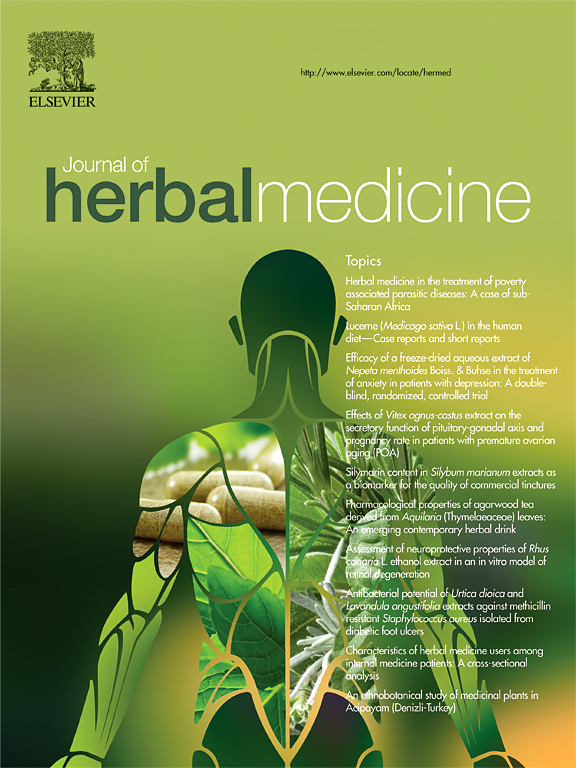Phytotherapy: A Systematic Review for the Treatment of Hypertension
IF 1.9
4区 医学
Q2 INTEGRATIVE & COMPLEMENTARY MEDICINE
引用次数: 0
Abstract
Introduction
Approximately 10 million annual deaths may be associated with hypertension. Adverse effects and non-response to pharmacological treatment limit therapy to a significant proportion of patients; hence, treatment alternatives seem necessary. Our objective was to review data about the impact of herbal medicine on reducing blood pressure (BP) in prehypertensive and hypertensive patients.
Methods
A systematic review was conducted (PRISMA guidelines), using PUBMED, SCOPUS, and WEB OF SCIENCE databases, without time restriction. The inclusion criteria were randomised controlled trials and quasi-experimental studies in humans focusing antihypertensive effect of phytotherapeutics: Allium sativum, Apium graveolens, Nigella sativa, Panax ginseng, and Hibiscus sabdariffa on BP in adults with prehypertension or hypertension. The exclusion criteria were the usage of combined medicinal plants. Data about systolic and diastolic BP differences before and after phytotherapy were extracted manually and summarised. The risk of bias was assessed using the JBI tool.
Results
Forty-five studies were selected (15 A sativum, 4 A graveolens, 4 N sativa, 9 P ginseng, and 13 H sabdariffa). Antihypertensive effect was observed for A sativum systolic and diastolic BP (−18.1/−9 mmHg), A graveolens (−37.9/−15.4 mmHg), N sativa (−11.8/−8.8 mmHg), P ginseng (−17.4/−7.1 mmHg), and H sabdariffa (−61.4/−66.2 mmHg).
Discussion/Conclusions
Herbal medicines can reduce high BP levels in prehypertension and hypertension, when used alone or together with lifestyle changes or antihypertensive drugs. Results interpretation is crucial, given the studies quality variation and the discrepancies. More consistent clinical studies in humans are needed to accurately determine efficacy and safety in the treatment of hypertension.

植物疗法:高血压治疗的系统综述
每年大约有1000万人的死亡可能与高血压有关。不良反应和对药物治疗的无反应限制了很大一部分患者的治疗;因此,替代治疗似乎是必要的。我们的目的是回顾有关草药对高血压前期和高血压患者降低血压(BP)影响的数据。方法采用PUBMED、SCOPUS和WEB OF SCIENCE数据库进行系统评价(PRISMA指南),不受时间限制。纳入标准是随机对照试验和准实验研究,重点关注植物疗法对高血压前期或高血压成人血压的降压作用:葱、荆芥、黑草、人参和芙蓉。排除标准为复方药用植物的使用。人工提取植物治疗前后的收缩压和舒张压差异数据并进行总结。使用JBI工具评估偏倚风险。结果共筛选45份研究,其中苜蓿15份,枸杞4份,苜蓿4份,人参9份,人参13份。A sativum收缩压和舒张压(−18.1/−9 mmHg)、A graveolens(−37.9/−15.4 mmHg)、N sativa(−11.8/−8.8 mmHg)、P ginseng(−17.4/−7.1 mmHg)和H sabdariffa(−61.4/−66.2 mmHg)均有降压作用。讨论/结论复方草药可降低高血压前期和高血压患者的高血压水平,可单独使用,也可与生活方式改变或降压药合用。考虑到研究质量的差异和差异,结果解释是至关重要的。需要更一致的人体临床研究来准确确定高血压治疗的有效性和安全性。
本文章由计算机程序翻译,如有差异,请以英文原文为准。
求助全文
约1分钟内获得全文
求助全文
来源期刊

Journal of Herbal Medicine
INTEGRATIVE & COMPLEMENTARY MEDICINE-
CiteScore
3.90
自引率
0.00%
发文量
94
期刊介绍:
The Journal of Herbal Medicine, the official journal of the National Institute of Medical Herbalists, is a peer reviewed journal which aims to serve its readers as an authoritative resource on the profession and practice of herbal medicine. The content areas of the journal reflect the interests of Medical Herbalists and other health professionals interested in the clinical and professional application of botanical medicines. The objective is to strengthen the research and educational base of herbal medicine with research papers in the form of case studies, original research articles and reviews, monographs, clinical trials and relevant in vitro studies. It also publishes policy statements, opinion pieces, book reviews, conference proceedings and profession related information such as pharmacovigilance reports providing an information source for not only the Herbal Practitioner but any Health professional with an interest in phytotherapy.
 求助内容:
求助内容: 应助结果提醒方式:
应助结果提醒方式:


